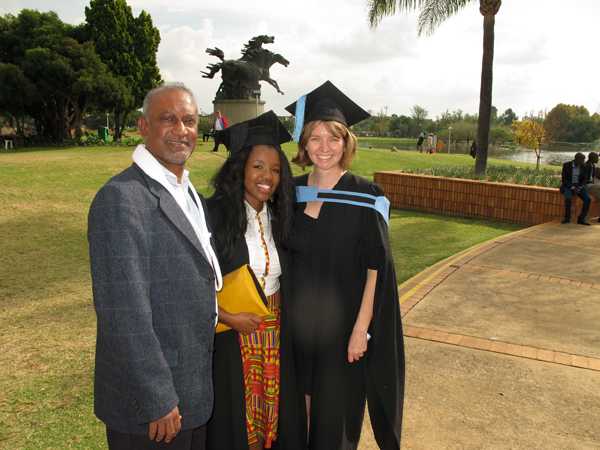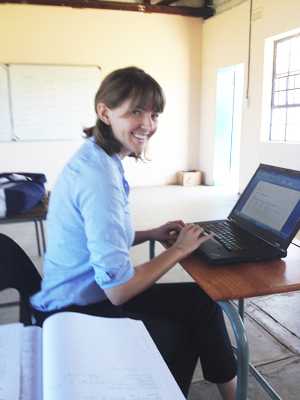2015 SAFETP Graduates Setting the Standard

Akhona Tshangela and Moira Beery (pictured above with the program director, Dr. Carl Reddy) are two of the successful graduates, and took the time to share their experiences with CDC South Africa.
2 South Africa Field Epidemiology Training Programme residents recently completed their training and were awarded Master of Public Health Degrees at the April 2015 graduation ceremony held at the University of Pretoria. A total of 58 residents have completed the 2 year residency and 44 have graduated and been awarded public health degrees since the SAFETP program began in 2006.
SAFETP is a two-year hands-on -training program in applied epidemiology. SAFETP's mission is to develop field epidemiology capacity to detect, respond to and prevent public health threats. To this end SAFETP:
- Provides a platform for building field epidemiology capacity for health professionals;
- Builds competency in outbreak investigation, disease surveillance, data analysis, hypothesis driven research through a two year residency, short courses and an intermediate course;
- Develops the capacity of health professionals to utilize evidence based approaches to drive programs and inform policy decisions; and
- Aligns program activities with national health priorities.
Akhona Tshangela: The world is my oyster
Prior to joining SAFETP, Akhona Tshangela studied at the University of Cape Town where she completed my BSc Honors in Medicine in Human Genetics. In 2009, she joined the Center for Respiratory Diseases and Meningitis (CRDM) at the National Institute for Communicable Diseases (NICD) in South Africa as a research medical scientist. "There I worked for two years focusing on the molecular epidemiology of Streptococcus pneumonia, which is a leading causal pathogen for pneumonia for children under 5 years. This environment sparked my interest in public health, but more specifically epidemiology. In 2011, I decided to explore further this growing passion and became a data analyst in the epidemiology unit within the same center," says Tshangela.
In this position she managed and maintained numerous surveillance databases and produced monthly reports on the trends of various pathogens. This exposure prompted her to study further and truly understand what epidemiology was, which led her to joiningSAFETP in 2013.

Akhona Tshangela
1. How were you introduced to the SAFETP?
I was first introduced to FETP in 2009 by a friend who was currently the cohort at the time. Working at NICD, where FETP is based, I also had the opportunity to attend some of the presentation given by the FETP residents at the scientific forums.
2. Why was SAFETP particularly suited to furthering your career goals?
Having been a lab rat for a couple of years I knew it wasn't something I wanted to do for the rest of my life. I wanted to go out there to the communities and implement preventative control measures for health events. FETP gave this practical component, while still also obtaining a master degree in public health. We were able to go into communities, work with various stakeholders and learn how to address health events and implement control measures. This was far more valuable than sitting in the classroom and be lectured on theory.
3. What has been the most challenging aspect of your SAFETP experience?
The most challenging aspect was being placed in the MRC/UNISA Violence and Injury Research Unit for my field placement. As someone coming from a communicable disease background, it took a moment to wrap my head around the various integrated components and challenges that came with those components in non-communicable diseases. I had to learn and understand that social determinants of health played an immense role in the escalating the burden of non-communicable diseases, especially in relation to violence and injury in this country.
4. What has been the high point of your SAFETP experience?
There have been many, but one specifically comes to mind. At my field placement they had implemented interventions to prevent burns, falls and other injuries in children by targeting early childhood development (ECD) centers in an informal settlement. They supplied classes for the teachers and provided educational materials to teach the children. It was really rewarding to visit some of these ECDs and watch the children re-enact what to do when their house caught fire as well as how to cross the street. It may seem like simple things however due to the low level of education in such areas they are not so simple. The children were also able to go and teach their parents about the importance of safety and even labeling poisonous and dangerous agents (such as paraffin) in the household. Therefore it was great to observe the fruits of the labor of the intervention and also the pride in the teachers that sometimes cannot even provide a child with a crayon to color in on a piece of paper.
Travelling to international conferences and meeting other epidemiologists and public health specialists and learning the different approaches they use to tackle their public health issues was also very rewarding. Another important high point was of course to graduate from the program.
5. Would you recommend SAFETP to others?
Yes. What you are exposed to as a FETP resident is much broader than most public health degrees. You are able to visualize the bigger picture and the many complicated components where health is concerned. I think this is an important skill to obtain to become a great leader in the health sector or even in any sector.
6. How does it feel to finally graduate?
Great! Now I can focus on improving the health system in my country. This obviously will not happen overnight but now I have been armed with the correct tools to at least try and implement change.
On completion of SAFETP I was told the world is my oyster - which it truly can be. I would like to see myself having made a real difference in health going forward, that is improving policies and being one of the key players to effect change in the health system. Knowledge is power and therefore I don't think I will ever stop growing, learning, and gaining experience.
7. How has your context changed as a result of SAFETP?
My mindset has definitely changed on health issues. Diplomacy has been one of the major skills I have acquired while in the program. In order to effect change in any situation one needs to be diplomatic or else all the great ideas in one’s head will be useless if you cannot get the buy in of stakeholders. This I could have never learned sitting in class or even in the lab. I also feel in South Africa as a country a lot still remains to be done in non-communicable diseases. They are extremely neglected and in the near future we may find ourselves with an even larger burden then currently if not adequately addressed and more resources are not directed to intervene to the burden.
8. Any further comments?
As a last word, I think as a continent we need to be grateful and acknowledge the support we receive from around the world. Without the U.S. Centers for Disease Control and Prevention (CDC) I doubt programs such SAFETP would be in existence. At the same time I also feel we need to own our health issues and tackle these issues more aggressively. We need to build infrastructure and human resources across the continent to reduce mortality of diseases that can be easily prevented and also to be prepared for disasters we may have no control over.
Moira Beery: SAFETP formed me into a scientist
Moira Beery’sacademic background is in the social sciences - she has a B.A. in Anthropology and a master’s degree in Urban and Regional Planning. For eight years prior to joining FETP she worked on food security and nutrition in positions that combined research and program implementation. “Some of the projects I have done were to establish food gardens and health and nutrition education programmes at schools in Johannesburg, to evaluate programmes of the Department of Agriculture for their impact on the food security of beneficiaries, and to partner with schools and farmers to improve the health of school meal programmes in Los Angeles,” said Beery.

Moira Beery
1. How were you introduced to the SAFETP?
I had been strongly considering moving into what I consider to be the more formal public health sphere in South Africa and I was debating getting an MPH but didn’t want to leave the working world for two years while I studied. A friend who had worked in the past with FETP sent me the call for applications. The more I learned about the program, the more appealing it was to me—it would allow me to study towards an MPH, but I would also get work experience through my field placement, outbreak investigation training, and I would have the opportunity to develop a new network of colleagues and classmates. The combination of classroom learning plus work in the real world convinced me that FETP was a fantastic opportunity that I couldn’t pass up.
2. Why was SAFETP particularly suited to furthering your career goals?
It was very important to me that I didn’t leave the working world for two years to pursue an MPH. Having had the experience of getting a master’s degree already and having a number of years of work experience, I know that I learn the most through work and real-world experiences, while I enjoy classroom learning also, I crave the other. The balance provided by FETP made me feel like the program’s training approach was in line with my preferred learning style.
3. What has been the most challenging aspect of your SAFETP experience?
Field work is the most fun and exhilarating aspect of FETP, but I found it to be the most challenging. I was in the office at 3pm on a Tuesday working on my research report and I got a call that I’d be leaving the following morning to investigate a diarrhoea outbreak at a college in KwaZulu-Natal. I pulled out my notes from our Outbreak Investigation course and reviewed the twelve steps and confidently set out. I imagined our team completing each of the twelve steps in an organized and systematic way and a week or so later sharing our detailed report with the cause of the outbreak identified, contained, and prevented from ever reemerging.
We arrived to a situation which felt like chaos to anyone coming with a checklist and a clip board, but was actually just the real world. We jumped into developing and distributing questionnaires, we collected food and water samples, and then we begged and pleaded with students for two days to give us stool samples, but not a single person was willing, in a residential school environment, they were just too embarrassed to do so. Just as we were wrapping up our investigation and seeing light at the end of the tunnel, a second outbreak of diarrhoea occurred at the school directly across the street so we repeated our investigation there. When we were finally back in Gauteng we faced further frustration when we learned that our samples had been improperly stored and the results, however compromised, were withheld for more than a week over disagreements about which department would pay for the laboratory analysis.
The layers of complication just kept coming. To me as a new researcher it felt overwhelming, but anyone with field work experience knows the best laid plans of the epidemiologist can easily fly out the window in the real world. Our job is to push through and do the best work we can in the circumstances, and the circumstances will never be ideal. If there is one thing you’ll always be assured of in this job it’s a little bit of chaos to keep you on your toes!
4. What has been the high point of your SAFETP experience?
I am very proud of the research project I did on cancer among female domestic workers. I was advised by a strong team of experienced cancer researchers at the National Cancer Registry, but in the end each piece of the research was my own. The completed research represents my ability to conceive of a research topic, to obtain ethics approval, to develop a methodology, conduct data analysis, and write up the findings in a paper. I am proud of the final product for each of these steps that it represents; looking back I can see how each aspect of the research process demonstrated my growth as a scientist. Furthermore, the paper represents my own learning curve, I knew little about cancer when I started SAFETP yet ended with a strong cancer research experience and output.
5. Would you recommend SAFETP to others?
I absolutely recommend SAFETP to any emerging field epidemiologists in South Africa. It is the only program of its kind in the country, and the opportunities offered in the span of two years would be impossible to match anywhere else. FETP is an especially good fit for someone like me who craves variety and new learning experiences, someone who is keen to travel within South Africa and internationally, and someone who wants to learn from true experts in the field. In exchange for two years of hard work and commitment to the program, SAFETP pretty much guarantees the skills to have an extremely interesting and rewarding career- it’s an incredibly worthwhile trade-off.
6. How does it feel to finally graduate?
Graduation felt wonderful! The two years of FETP were a whirlwind. I was involved in so many different projects and based in so many different locations. There was much work to be done, right up until the very last day, so the end of the programme snuck up on me quickly. Attending graduation in April was a sweet way to tie up the experience, I appreciated pausing to look back on those two years and celebrate the accomplishment and a job well done.
I am currently working as a Researcher on the Adolescent Innovations Project at the Wits Reproductive Health & HIV Institute. The project I work on combines research with programme implementation, which feels ideal for me and my interests. I haven’t worked with a large dataset since I left FETP and my fingers are getting itchy, so I definitely hope for more opportunities to conduct data analysis in the near future - something that two years ago I never thought I would say!
7. How has your context changed as a result of SAFETP?
I say without hesitation that SAFETP formed me into a scientist. I was an experienced public health programme manager before joining SAFETP but my focus was not necessarily on generating evidence and responding to evidence. SAFETP has forever changed that for me, as a result of the training I received I see the most important role of a public health practitioner to be engaging in evidence-based work and generating new evidence. With this as my outlook, my context has changed to research and implementation based in science. I find the focus provided by this approach to be very grounding and motivating.
8. Any further comments?
I am very humbled as I look back on FETP and realize just how much was invested in each of us residents. The time and expertise shared with us, the money spent on our stipends and school fees, the planning that went into our training and providing us with field experience was enormous. I don’t think I ever have had, or ever will again have, such an investment made in me. I appreciate it so much and I don’t take it lightly. Now that I am on the other end of my FETP training, I feel compelled to pursue a career in this field not out of an obligation to return the investment, but because for two years I was surrounded by people who were inspiring, who had exciting careers, and who imparted the skills and the motivation to contribute meaningfully to public health in South Africa. It’s my goal to take that training and investment and make good on it. I give huge thanks to the FETP staff and my field supervisor and colleagues at the National Cancer Registry who have mentored me and shaped me into someone who is hopefully worthy of being their colleague.
- Page last reviewed: June 29, 2015
- Page last updated: June 29, 2015
- Content source:
Global Health
Notice: Linking to a non-federal site does not constitute an endorsement by HHS, CDC or any of its employees of the sponsors or the information and products presented on the site.


 ShareCompartir
ShareCompartir